2004 ISUZU TF SERIES Throttle Position Sensor
[x] Cancel search: Throttle Position SensorPage 1659 of 4264
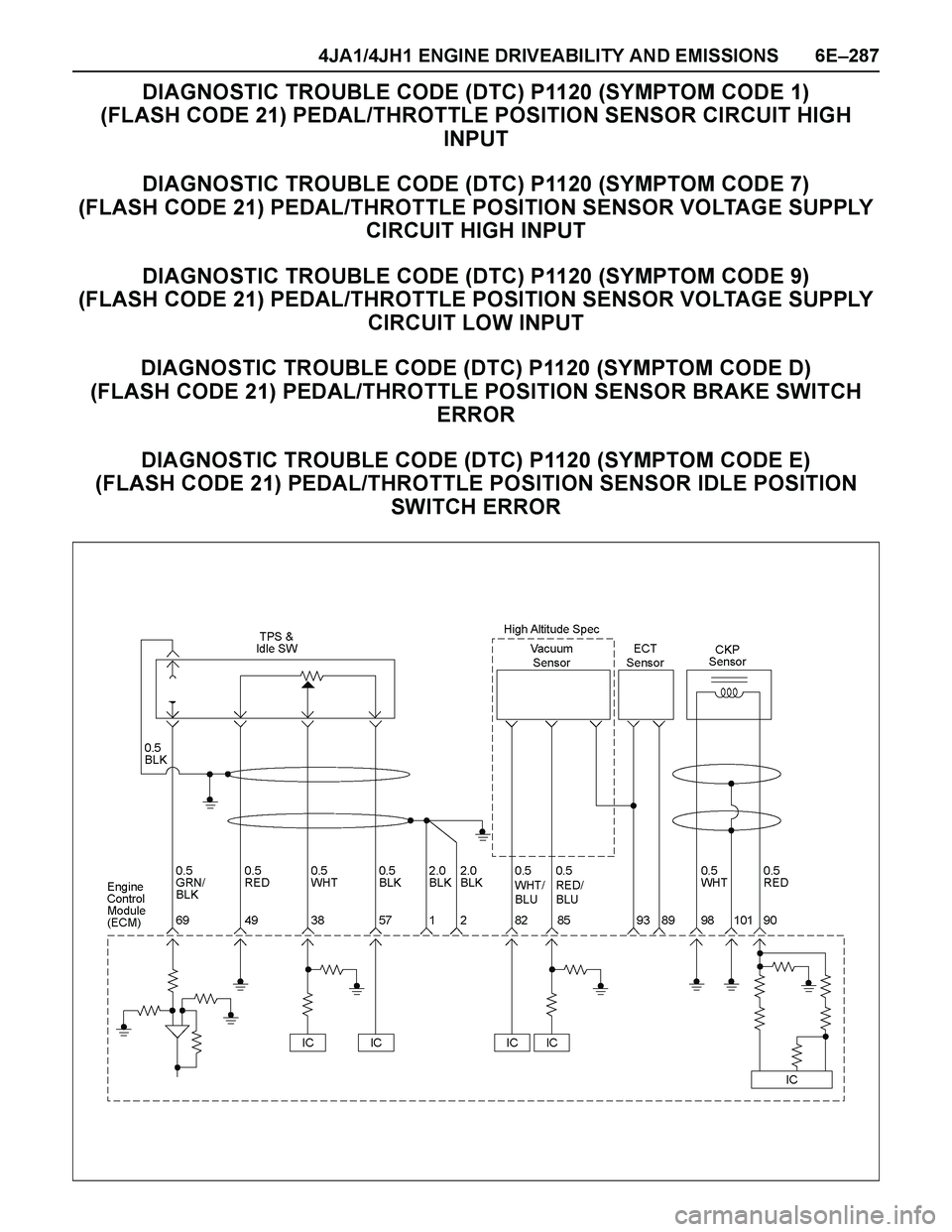
4JA1/4JH1 ENGINE DRIVEABILITY AND EMISSIONS 6E–287
DIAGNOSTIC TROUBLE CODE (DTC) P1120 (SYMPTOM CODE 1)
(FLASH CODE 21) PEDAL/THROTTLE POSITION SENSOR CIRCUIT HIGH
INPUT
DIAGNOSTIC TROUBLE CODE (DTC) P1120 (SYMPTOM CODE 7)
(FLASH CODE 21) PEDAL/THROTTLE POSITION SENSOR VOLTAGE SUPPLY
CIRCUIT HIGH INPUT
DIAGNOSTIC TROUBLE CODE (DTC) P1120 (SYMPTOM CODE 9)
(FLASH CODE 21) PEDAL/THROTTLE POSITION SENSOR VOLTAGE SUPPLY
CIRCUIT LOW INPUT
DIAGNOSTIC TROUBLE CODE (DTC) P1120 (SYMPTOM CODE D)
(FLASH CODE 21) PEDAL/THROTTLE POSITION SENSOR BRAKE SWITCH
ERROR
DIAGNOSTIC TROUBLE CODE (DTC) P1120 (SYMPTOM CODE E)
(FLASH CODE 21) PEDAL/THROTTLE POSITION SENSOR IDLE POSITION
SWITCH ERROR
Page 1660 of 4264

6E–288 4JA1/4JH1 ENGINE DRIVEABILITY AND EMISSIONS
Condition for setting the DTC and action taken when the DTC sets
Circuit Description
The TPS is a potentiometer connected to throttle shaft
on the throttle body. It is installed to the main TPS and
idle switch.
The engine control module (ECM) monitors the voltage
on the signal line and calculates throttle position. As the
throttle valve angle is changed when accelerator pedal
moved. The TPS signal also changed at a moved
throttle valve. As the throttle valve opens, the output
increases so that the output voltage should be high.
The ECM monitors the TPS supply voltage and TPS
output voltage. The supply voltage is out of range, DTC
P1120 (Symptom Code 7) or P1120 (Symptom Code 9)
will be stored. The output voltage excessively high, DTC
P1120 (Symptom Code 1) will be stored.
If the brake pedal is depressed during accelerator pedal
is depressing, DTC P1120 (Symptom Code D) will be
stored.
If the relation of idle switch and TPS position are
incorrect, DTC P1120 (Symptom Code E) will be stored.
Diagnostic Aids
An intermittent may be caused by the following:
Poor connections.
Misrouted harness.
Rubbed through wire insulation.
Broken wire inside the insulation.
Check for the following conditions:
Poor connection at ECM-Inspect harness connectors
for backed out terminals, improper mating, broken
locks, improperly formed or damaged terminals, and
poor terminal to wire connection.
Damaged harness-Inspect the wiring harness for
damage. If the harness appears to be OK, observe
the “Throttle Position”, “Idle Switch”, “Brake Switch 1”
and “Brake Switch 2” display on the Tech2 while
moving connectors and wiring harness related to the
sensor.
Diagnostic Trouble Code (DTC) P1120 (Sy mptom Code 1) (Flash Code 21)
Pedal/Throttle Position Sensor Circuit High Input
Flash
CodeCode Symptom
CodeMIL DTC Name DTC Setting Condition Fail-Safe (Back Up)
21 P1120 1 ON Pedal/Throttle Position Sen-
sor Circuit High InputThrottle position sensor out-
put voltage is more than 4.5V.ECM increa ses idle spe ed up
to 1400rpm.
7 ON Pedal/Throttle Position Sen-
sor Voltage Supply Circuit
High InputThrottle position sensor
power supply voltage is more
than 5.2V.
9 ON Pedal/Throttle Position Sen-
sor Voltage Supply Circuit
Lo w InputThrottle position sensor
power supply voltage is below
4.6V.
D ON Pedal/Throttle Position Sen-
sor Brake Switch Error1. Engine speed is more than
1700rpm.
2. Vehicle speed is more than
1.5km/h.
3. When brake pedal is
depressed during accelera-
tor pe da l is de pre ssing.
E ON Pedal/Throttle Position Sen-
sor Idle Position Switch Error1. Whe n idle switch is turne d
o ff, thro ttle positio n se nsor
wa s be lo w 0.35%.
or
2. Whe n idle switch is tune d
on, throttle position sensor
was more than 7.8%.
Step Action Value(s) Yes No
1Was the “On-Board Diagnostic (OBD) System Check”
performed?
—Go to Step 2Go to On Board
Diagnostic
(OBD) System
Check
Page 1665 of 4264
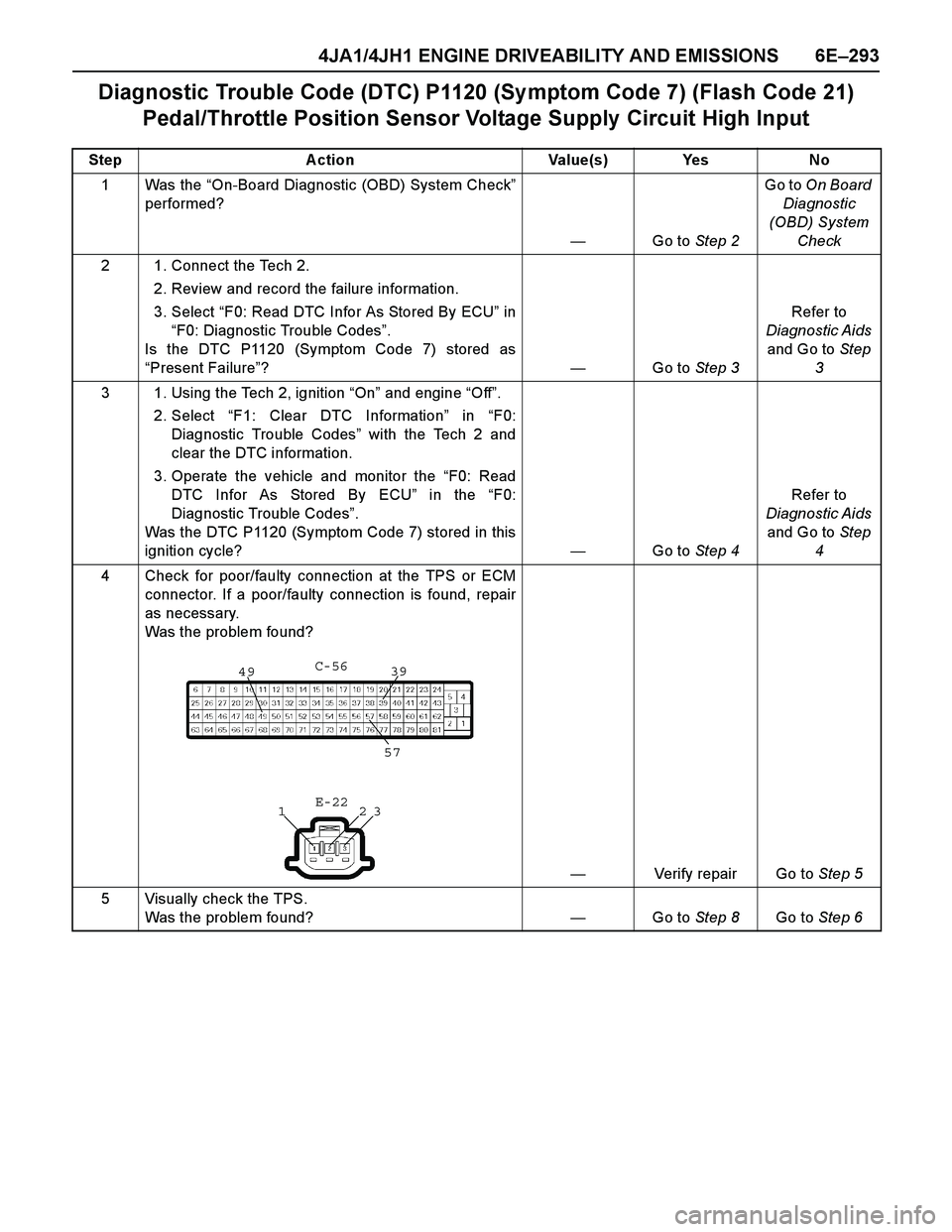
4JA1/4JH1 ENGINE DRIVEABILITY AND EMISSIONS 6E–293
Diagnostic Trouble Code (DTC) P1120 (Sy mptom Code 7) (Flash Code 21)
Pedal/Throttle Position Sensor Voltage Supply Circuit High Input
Step Action Value(s) Yes No
1Was the “On-Board Diagnostic (OBD) System Check”
performed?
—Go to Step 2Go to On Board
Diagnostic
(OBD) System
Check
2 1. Connect the Tech 2.
2. Review and record the failure information.
3. Select “F0: Read DTC Infor As Stored By ECU” in
“F0: Diagnostic Trouble Codes”.
Is the DTC P1120 (Symptom Code 7) stored as
“Present Failure”?—Go to Step 3Refer to
Diagnostic Aids
and Go to Step
3
3 1. Using the Tech 2, ignition “On” and engine “Off”.
2. Select “F1: Clear DTC Information” in “F0:
Diagnostic Trouble Codes” with the Tech 2 and
clear the DTC information.
3. Operate the vehicle and monitor the “F0: Read
DTC Infor As Stored By ECU” in the “F0:
Diagnostic Trouble Codes”.
Was the DTC P1120 (Symptom Code 7) stored in this
ignition cycle?—Go to Step 4Refer to
Diagnostic Aids
and Go to Step
4
4 Check for poor/faulty connection at the TPS or ECM
connector. If a poor/faulty connection is found, repair
as necessary.
Was the problem found?
—Verify repair Go to Step 5
5 Visually check the TPS.
Was the problem found? —Go to Step 8Go to Step 6
4939
57
23 1C-56
E-22
Page 1667 of 4264
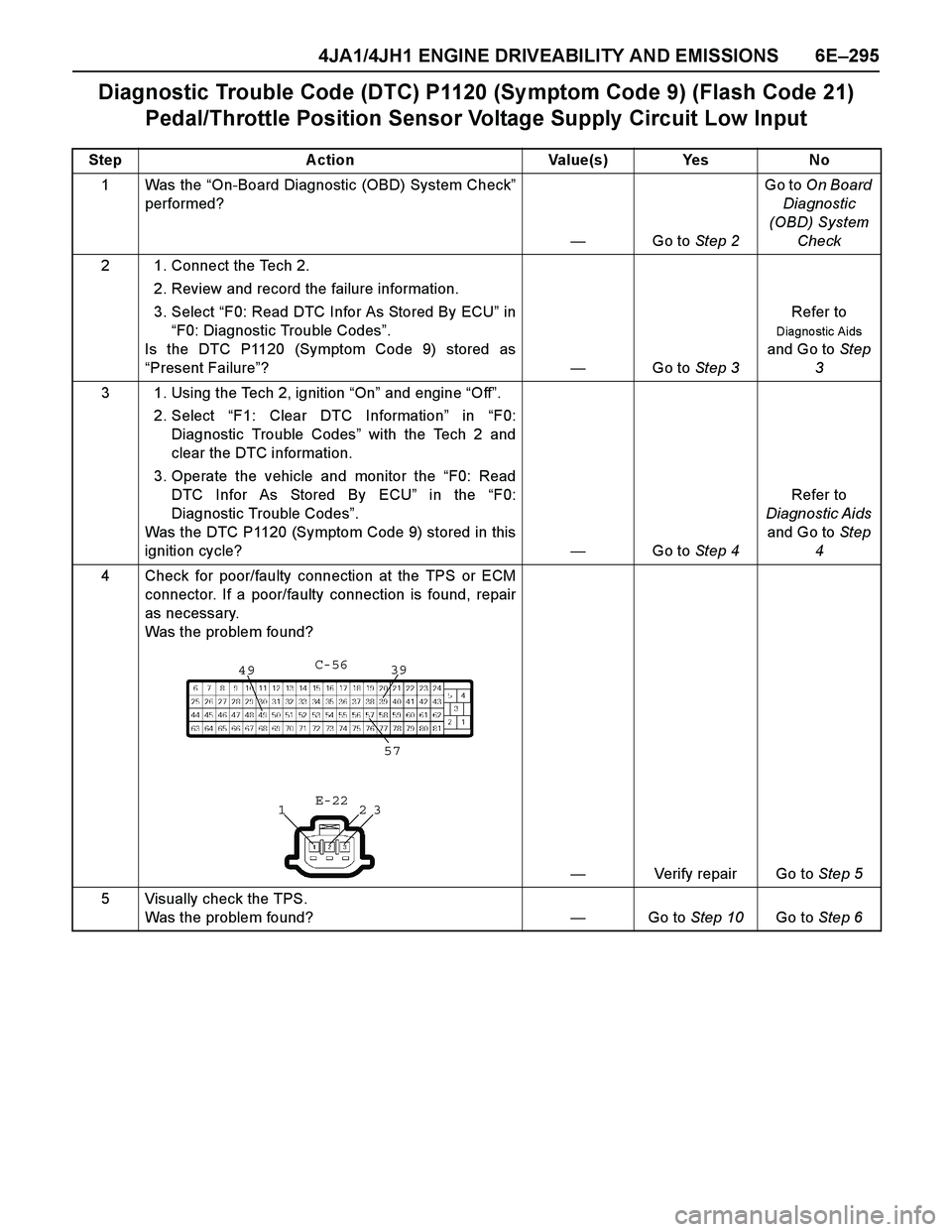
4JA1/4JH1 ENGINE DRIVEABILITY AND EMISSIONS 6E–295
Diagnostic Trouble Code (DTC) P1120 (Sy mptom Code 9) (Flash Code 21)
Pedal/Throttle Position Sensor Voltage Supply Circuit Low Input
Step Action Value(s) Yes No
1Was the “On-Board Diagnostic (OBD) System Check”
performed?
—Go to Step 2Go to On Board
Diagnostic
(OBD) System
Check
2 1. Connect the Tech 2.
2. Review and record the failure information.
3. Select “F0: Read DTC Infor As Stored By ECU” in
“F0: Diagnostic Trouble Codes”.
Is the DTC P1120 (Symptom Code 9) stored as
“Present Failure”?—Go to Step 3Refer to
Diagno stic Aids
and Go to Step
3
3 1. Using the Tech 2, ignition “On” and engine “Off”.
2. Select “F1: Clear DTC Information” in “F0:
Diagnostic Trouble Codes” with the Tech 2 and
clear the DTC information.
3. Operate the vehicle and monitor the “F0: Read
DTC Infor As Stored By ECU” in the “F0:
Diagnostic Trouble Codes”.
Was the DTC P1120 (Symptom Code 9) stored in this
ignition cycle?—Go to Step 4Refer to
Diagnostic Aids
and Go to Step
4
4 Check for poor/faulty connection at the TPS or ECM
connector. If a poor/faulty connection is found, repair
as necessary.
Was the problem found?
—Verify repair Go to Step 5
5 Visually check the TPS.
Was the problem found? —Go to Step 10Go to Step 6
4939
57
23 1C-56
E-22
Page 1670 of 4264

6E–298 4JA1/4JH1 ENGINE DRIVEABILITY AND EMISSIONS
Diagnostic Trouble Code (DTC) P1120 (Sy mptom Code D) (Flash Code 21)
Pedal/Throttle Position Sensor Brake Switch Error
Step Action Value(s) Yes No
1Was the “On-Board Diagnostic (OBD) System Check”
performed?
—Go to Step 2Go to On Board
Diagnostic
(OBD) System
Check
2 1. Connect the Tech 2.
2. Review and record the failure information.
3. Select “F0: Read DTC Infor As Stored By ECU” in
“F0: Diagnostic Trouble Codes”.
Is the DTC P1120 (Symptom Code D) stored as
“Present Failure”?—Go to Step 3Refer to
Diagnostic Aids
and Go to Step
3
3 1. Using the Tech 2, ignition “On” and engine “Off”.
2. Select “F1: Clear DTC Information” in “F0:
Diagnostic Trouble Codes” with the Tech 2 and
clear the DTC information.
3. Operate the vehicle and monitor the “F0: Read
DTC Infor As Stored By ECU” in the “F0:
Diagnostic Trouble Codes”.
Was the DTC P1120 (Symptom Code D) stored in this
ignition cycle?—Go to Step 4Refer to
Diagnostic Aids
and Go to Step
4
4 Visually check the TPS.
Check for the following conditions.
Accelerator pedal sticking.
If a problem is found, repair as necessary.
Was the problem found? —Verify repair Go to Step 5
5 1. Using the Tech 2, ignition “On” and engine “Off”.
2. Monitor the “Throttle Position” in the data display.
Does the Tech 2 indicate correct “Throttle Position”
from 0% to 100% depending on accelerator pedal
operation?—Go to Step 7Go to Step 6
6 1. Using the Tech 2, ignition “On” and engine “Off”.
2. Monitor the “Throttle Position” in the data display.
3. Adjust the TPS within 0% to 100%.
Was the problem solved?—Verify repair Go to Step 11
7 1. Using the Tech 2, ignition “On” and engine “Off”.
2. Monitor the “Brake Switch 1” and “Brake Switch 2”
in the data display.
Does the Tech 2 indicate “Inactive” when the brake
pedal was not stepped on?—Go to Step 13Go to Step 8
8 Adjust the brake switch.
Was the problem solved?—Verify repair Go to Step 9
9 Substitute a known good brake switch and recheck.
Was the problem solved?—Go to Step 10Go to Step 13
10 Replace the brake switch.
Is the action complete?—Verify repair—
11 Substitute a known good TPS and recheck.
Was the problem solved?—Go to Step 12Go to Step 13
12 Replace the TPS.
Is the action complete?—Verify repair—
Page 1672 of 4264
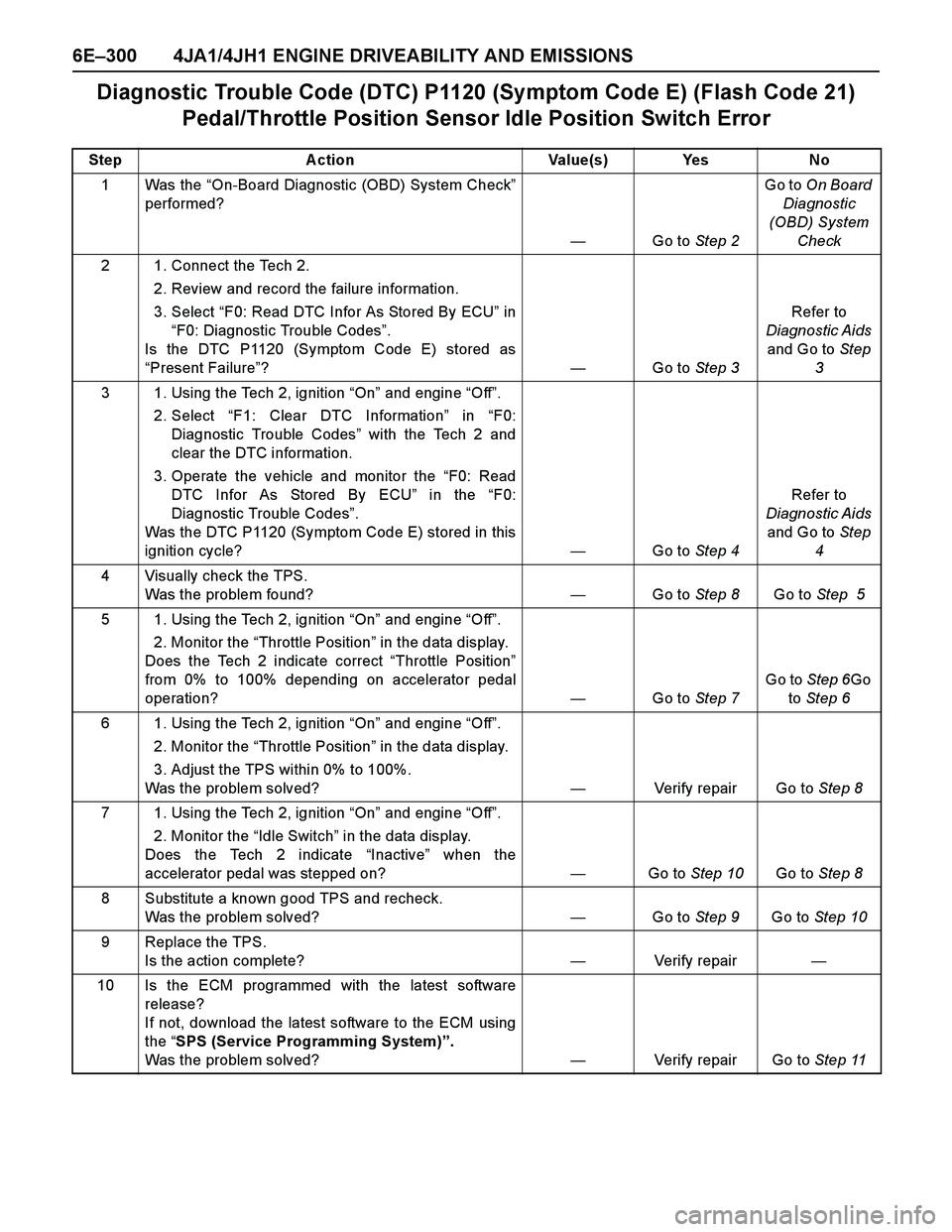
6E–300 4JA1/4JH1 ENGINE DRIVEABILITY AND EMISSIONS
Diagnostic Trouble Code (DTC) P1120 (Symptom Code E) (Flash Code 21)
Pedal/Throttle Position Sensor Idle Position Switch Error
Step Action Value(s) Yes No
1Was the “On-Board Diagnostic (OBD) System Check”
performed?
—Go to Step 2Go to On Board
Diagnostic
(OBD) System
Check
2 1. Connect the Tech 2.
2. Review and record the failure information.
3. Select “F0: Read DTC Infor As Stored By ECU” in
“F0: Diagnostic Trouble Codes”.
Is the DTC P1120 (Symptom Code E) stored as
“Present Failure”?—Go to Step 3Refer to
Diagnostic Aids
and Go to Step
3
3 1. Using the Tech 2, ignition “On” and engine “Off”.
2. Select “F1: Clear DTC Information” in “F0:
Diagnostic Trouble Codes” with the Tech 2 and
clear the DTC information.
3. Operate the vehicle and monitor the “F0: Read
DTC Infor As Stored By ECU” in the “F0:
Diagnostic Trouble Codes”.
Was the DTC P1120 (Symptom Code E) stored in this
ignition cycle?—Go to Step 4Refer to
Diagnostic Aids
and Go to Step
4
4 Visually check the TPS.
Was the problem found? —Go to Step 8Go to Step 5
5 1. Using the Tech 2, ignition “On” and engine “Off”.
2. Monitor the “Throttle Position” in the data display.
Does the Tech 2 indicate correct “Throttle Position”
from 0% to 100% depending on accelerator pedal
operation?—Go to Step 7Go to Step 6Go
to Step 6
6 1. Using the Tech 2, ignition “On” and engine “Off”.
2. Monitor the “Throttle Position” in the data display.
3. Adjust the TPS within 0% to 100%.
Was the problem solved?—Verify repair Go to Step 8
7 1. Using the Tech 2, ignition “On” and engine “Off”.
2. Monitor the “Idle Switch” in the data display.
Does the Tech 2 indicate “Inactive” when the
accelerator pedal was stepped on?—Go to Step 10Go to Step 8
8 Substitute a known good TPS and recheck.
Was the problem solved?—Go to Step 9Go to Step 10
9 Replace the TPS.
Is the action complete?—Verify repair—
10 Is the ECM programmed with the latest software
release?
If not, download the latest software to the ECM using
the “SPS (Service Programming System)”.
Was the problem solved?—Verify repair Go to Step 11
Page 1743 of 4264
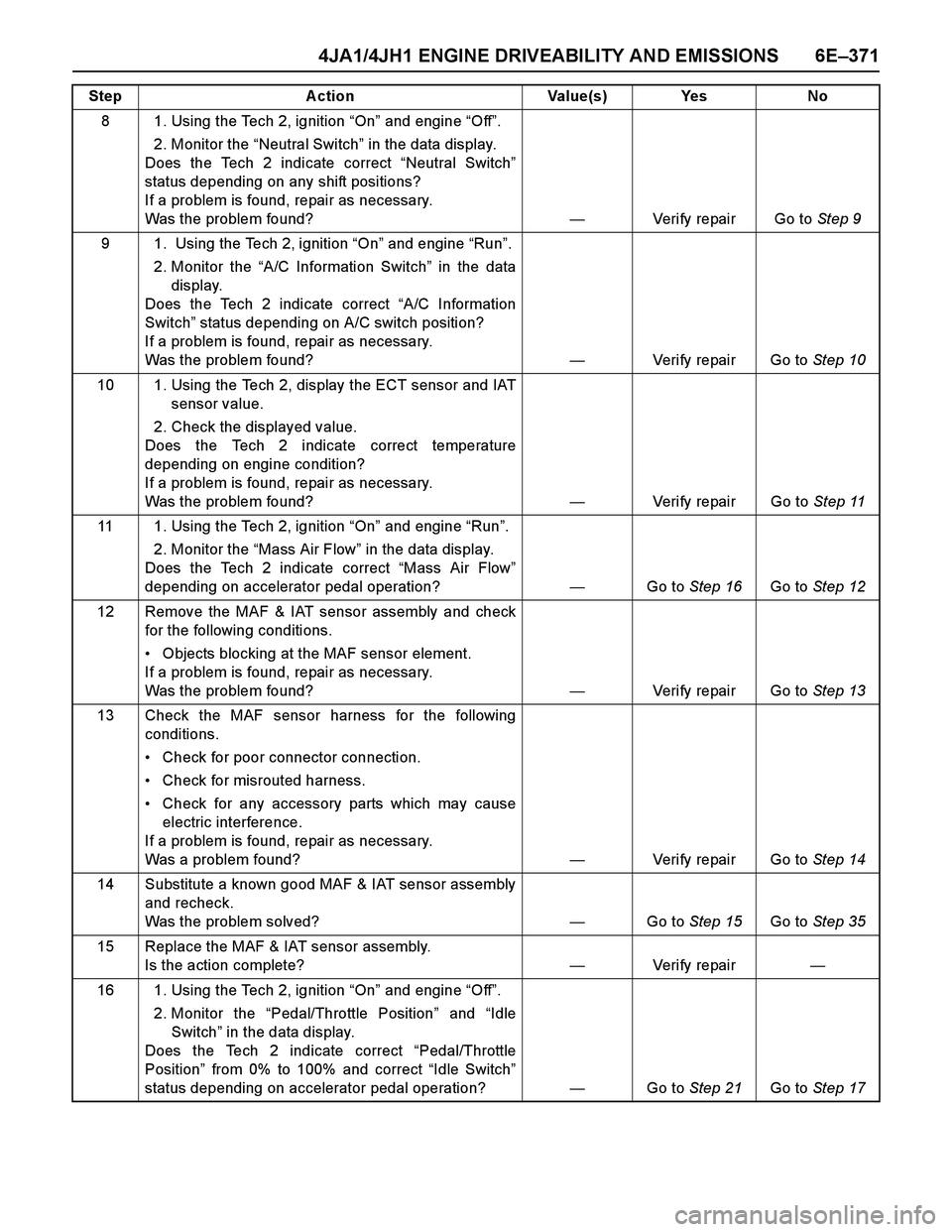
4JA1/4JH1 ENGINE DRIVEABILITY AND EMISSIONS 6E–371
8 1. Using the Tech 2, ignition “On” and engine “Off”.
2. Monitor the “Neutral Switch” in the data display.
Does the Tech 2 indicate correct “Neutral Switch”
status depending on any shift positions?
If a problem is found, repair as necessary.
Was the problem found?—Verify repair Go to Step 9
9 1. Using the Tech 2, ignition “On” and engine “Run”.
2. Monitor the “A/C Information Switch” in the data
display.
Does the Tech 2 indicate correct “A/C Information
Switch” status depending on A/C switch position?
If a problem is found, repair as necessary.
Was the problem found?—Verify repair Go to Step 10
10 1. Using the Tech 2, display the ECT sensor and IAT
sensor value.
2. Check the displayed value.
Does the Tech 2 indicate correct temperature
depending on engine condition?
If a problem is found, repair as necessary.
Was the problem found?—Verify repair Go to Step 11
11 1. Using the Tech 2, ignition “On” and engine “Run”.
2. Monitor the “Mass Air Flow” in the data display.
Does the Tech 2 indicate correct “Mass Air Flow”
depending on accelerator pedal operation? —Go to Step 16Go to Step 12
12 Remove the MAF & IAT sensor assembly and check
for the following conditions.
Objects blocking at the MAF sensor element.
If a problem is found, repair as necessary.
Was the problem found?—Verify repair Go to Step 13
13 Check the MAF sensor harness for the following
conditions.
Check for poor connector connection.
Check for misrouted harness.
Check for any accessory parts which may cause
electric interference.
If a problem is found, repair as necessary.
Was a problem found? —Verify repair Go to Step 14
14 Substitute a known good MAF & IAT sensor assembly
and recheck.
Was the problem solved?—Go to Step 15Go to Step 35
15 Replace the MAF & IAT sensor assembly.
Is the action complete?—Veri fy repai r—
16 1. Using the Tech 2, ignition “On” and engine “Off”.
2. Monitor the “Pedal/Throttle Position” and “Idle
Switch” in the data display.
Does the Tech 2 indicate correct “Pedal/Throttle
Position” from 0% to 100% and correct “Idle Switch”
status depending on accelerator pedal operation?—Go to Step 21Go to Step 17 Step Action Value(s) Yes No
Page 1744 of 4264
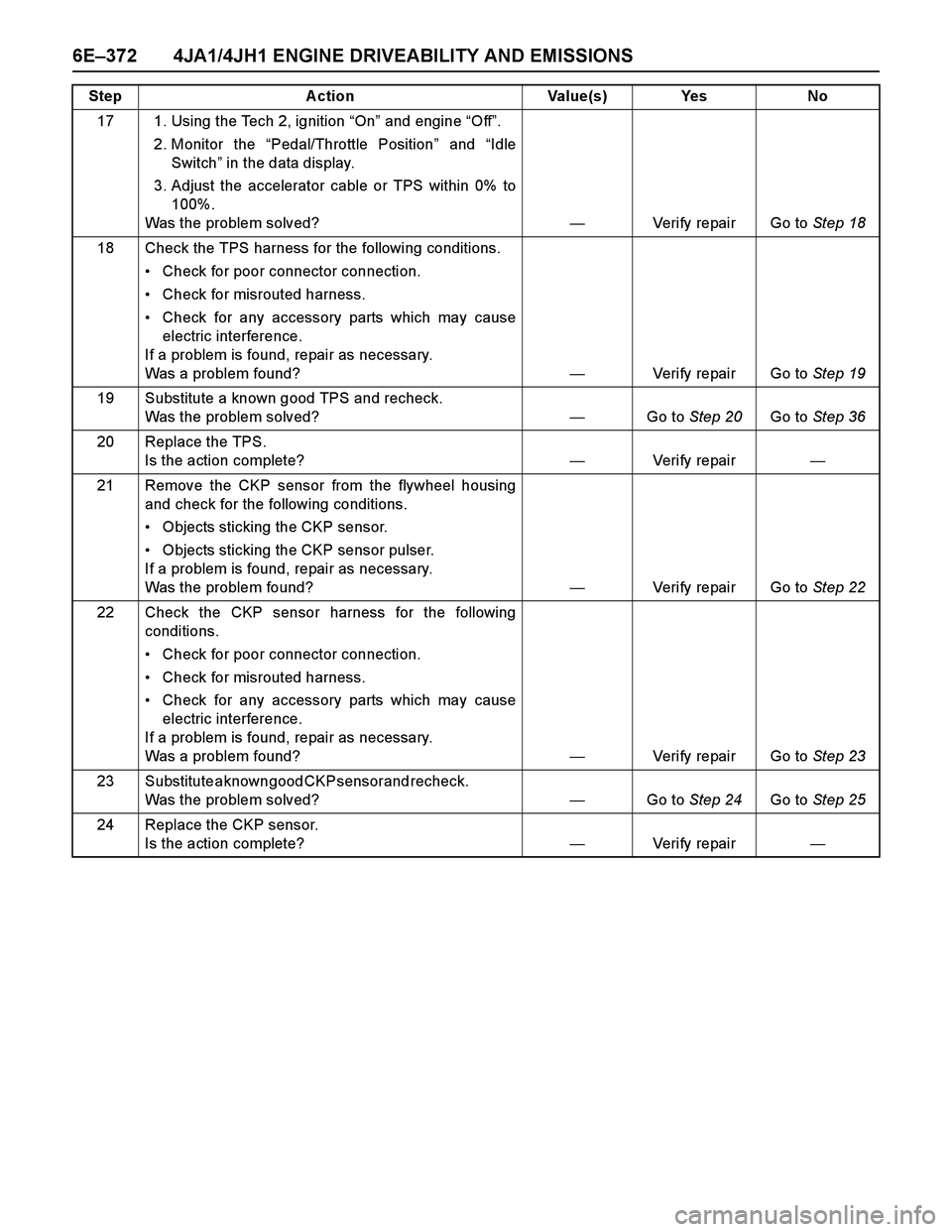
6E–372 4JA1/4JH1 ENGINE DRIVEABILITY AND EMISSIONS
17 1. Using the Tech 2, ignition “On” and engine “Off”.
2. Monitor the “Pedal/Throttle Position” and “Idle
Switch” in the data display.
3. Adjust the accelerator cable or TPS within 0% to
100%.
Was the problem solved?—Verify repair Go to Step 18
18 Check the TPS harness for the following conditions.
Check for poor connector connection.
Check for misrouted harness.
Check for any accessory parts which may cause
electric interference.
If a problem is found, repair as necessary.
Was a problem found? —Verify repair Go to Step 19
19 Substitute a known good TPS and recheck.
Was the problem solved?—Go to Step 20Go to Step 36
20 Replace the TPS.
Is the action complete?—Veri fy repai r—
21 Remove the CKP sensor from the flywheel housing
and check for the following conditions.
Objects sticking the CKP sensor.
Objects sticking the CKP sensor pulser.
If a problem is found, repair as necessary.
Was the problem found? —Verify repair Go to Step 22
22 Check the CKP sensor harness for the following
conditions.
Check for poor connector connection.
Check for misrouted harness.
Check for any accessory parts which may cause
electric interference.
If a problem is found, repair as necessary.
Was a problem found? —Verify repair Go to Step 23
23 Substitute a known good CKP sensor and recheck.
Was the problem solved?—Go to Step 24Go to Step 25
24 Replace the CKP sensor.
Is the action complete?—Veri fy repai r— Step Action Value(s) Yes No